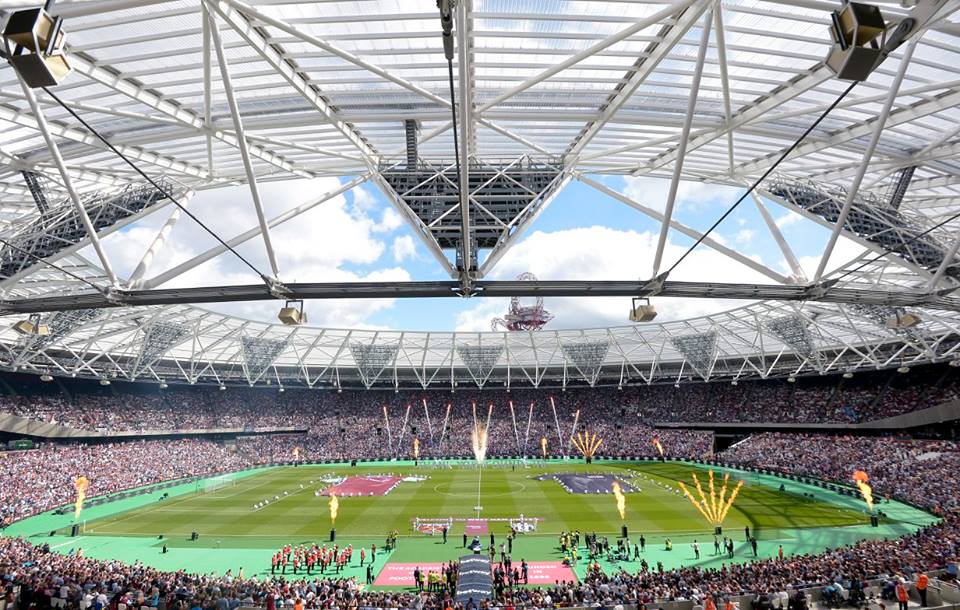The biggest stadium development for this year’s Premier League season will be the move of West Ham from historic Upton Park to the former London Olympic Stadium, which has been renovated for their use at a cost of over 272 million pounds.
Upton Park, otherwise known as the Boleyn Ground, was home to West Ham United since 1904, hosting 2,398 games during its long life. But, after the 2012 Olympics, West Ham recognized the financial potential of becoming the stadium’s post-Olympic anchor tenant. After fending off bids from London clubs Tottenham and Leyton Orient, West Ham is poised to start their first season in their new home.
For football, the stadium will hold 60,000 fans, making it the third largest in the league, behind only Manchester United’s Old Trafford and Arsenal’s Emirates stadiums.
As part of the stadium legacy plan, the renovated facility will also be used for other athletic events. There are 21,000 seats that can be pushed back from the football pitch to reveal a running track – though the conversion reportedly takes up to ten days to complete. The 2017 World Championships will be run at the stadium next August.
The majority of the cost of the conversion from Olympic to football stadium will be from public funds, including 40 million pounds from the local government, Newham Council. The club has also paid 15 million toward the renovation, and will pay 2.5 million pounds per year for the term of their 99-year lease.
Many alterations were made in order to make the switch from Olympics to football. The exterior was transformed by 86 claret and blue West Ham banners, with the remaining space slated for HD digital screens, including the largest in Europe – 272 feet wide and 39 feet high – which is expected to be operational by October.
The pitch, which is made from Desso GrassMaster, is 97% natural grass and 3% artificial fiber for turf security and drainage. It will be five yards longer and wider than the Upton Park pitch.
The size of the roof was doubled to cover every seat in the stadium, and at 276 feet, it is the longest cantilevered roof in the world. The reinforcement of the existing structure to handle the weight of the new roof cost 36 million pounds.
In fact, the scale of everything has been substantially increased as compared to Upton Park. The new stadium store, spread over two floors, is three times larger. The stadium features 3600 corporate seats and 16 executive boxes. In fact, it should be convenient for all fans – Olympic Park will have 36 catering outlets, 92 turnstiles, and 1000 toilets (compared to 283 at Upton Park…).
The new stadium also has American ties. Originally opened in 2011 at a cost of 486 million pounds, it was designed by American architectural firm Populous. The two new HD LED interior stadium screens were made by South Dakota-based Daktronics. Curved for better viewing angles – at 88 feet wide and 26 feet high – they’re the biggest screens in the Premier League.
Located in Queen Elizabeth Olympic Park, the stadium will be mush easier to access. Nine direct rail links and 20 bus routes serve the park. It is a short walk from the Stratford underground and international train stations – 58 trains every hour will make getting to and from games much easier than the old park, which was notoriously difficult to reach.
Although the facilities are new, many traditions will be continued. Two of the stand names were carried over from Upton Park –the Bobby Moore and Sir Trevor Brooking stand names. One of the most unique features of West Ham games, the bubble machines that produce bubbles as the fans sing along to their anthem, “I’m Forever Blowing Bubbles,” have been brought over for continuity.
Early signs point to financial success in the new move. The team announced in May of last year that they sold out the 50,000 season tickets on offer. The team suggests that makes them the London team with the highest number of season ticket holders, and the highest percentage of season ticket holders in the Premier League.
It is an exciting time for West Ham United – though it’s hard to leave behind the traditional home of the club, a grand old palace of the game, the new stadium is a major growth opportunity dropped in their laps. Rather than starting from scratch on a new stadium, they only had to renovate an existing gem that just happened to appear in their neighborhood. It should provide a fine home for Hammers for years to come.
Image courtesy of West Ham United.

